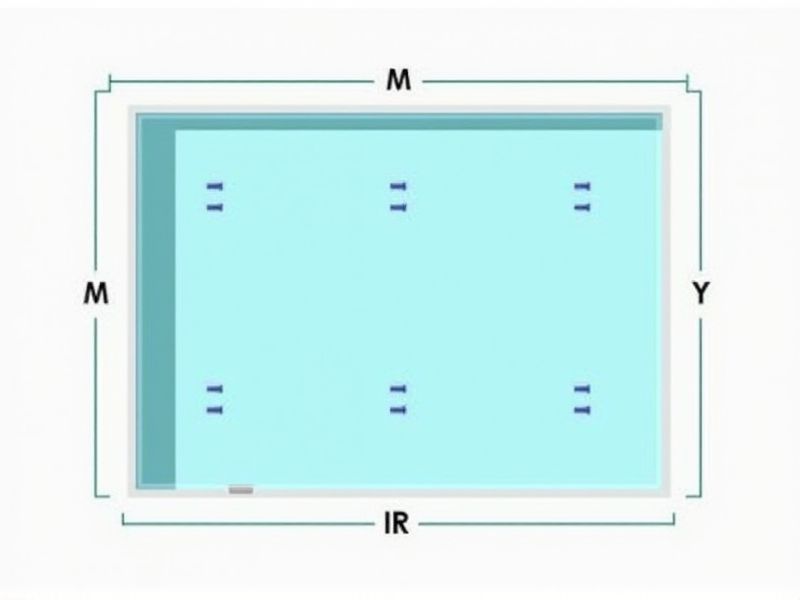
When designing or using a swimming pool, it's helpful to know that the standard width of a swimming lane is typically 2.5 meters (about 8.2 feet), as set by the International Swimming Federation (FINA). This ensures each swimmer has enough space to swim comfortably and safely, reducing the risk of accidental collisions. For competitive swimming, official pools usually have either 8 or 10 lanes, and each lane is marked by floating lane lines to separate them clearly. Keeping these standard dimensions in mind can help you create or use a pool that meets recognized safety and competition guidelines.
Lane Width
The standard width of a competitive swimming lane is typically 2.5 meters, as established by the International Swimming Federation (FINA). This lane width ensures optimal space for swimmers, allowing a minimal drag effect and enhancing race conditions. You will find that more than 8 lanes are often utilized in elite competitions, harnessing the efficiency of the lane design to accommodate numerous athletes simultaneously. Adequate lane width also contributes to the safety and comfort of swimmers during events, minimizing the risk of contact and ensuring a fair competition.
Pool Length
The standard length for competitive swimming pools is 50 meters, commonly referred to as an Olympic-size pool. For short course events, pools measure 25 meters in length. Each lane within these pools typically ranges from 2 to 2.5 meters wide, allowing swimmers adequate space to navigate without interference. Understanding these specifications is crucial for training, competition preparation, and ensuring compliance with international swimming regulations.
Pool Width
The standard width of a swimming lane in competitive pools is typically 2.5 meters, allowing swimmers ample space to navigate without interference. For optimal performance, pool dimensions for international competitions, such as the Olympic Games, require a minimum length of 50 meters. Properly designed lanes also account for eight to ten swimmers per event, ensuring that each athlete has a dedicated space during heats. Consistent lane width not only enhances safety but also contributes to fair competition by minimizing the impact of water turbulence.
Lane Markings
Swimming lane standards emphasize precise lane markings, which are essential for competitive events. Typically, each lane is marked with a solid line, often 5 centimeters wide, to designate boundaries clearly. For pool dimensions of 25 meters, lane lines are usually spaced 2.5 meters apart, providing adequate separation for swimmers. Proper adherence to these standards ensures the safety and efficiency of performances during competitions.
Depth Of Pool
The standard for swimming lane dimensions emphasizes a minimum depth of 2 meters for competitive pools, ensuring safety and performance. A deeper pool mitigates wave reflection and turbulence, providing swimmers with optimal conditions during races. For recreational facilities, a depth of at least 1.2 meters is recommended to accommodate diverse swimming activities. Ensuring adequate depth also supports lifeguard effectiveness, offering a safer environment for all swimmers.
Starting Blocks
Starting blocks are essential in competitive swimming, providing swimmers with a stable and elevated platform for explosive starts. Manufactured to meet FINA regulations, these blocks feature adjustable footrests and slip-resistant surfaces to enhance grip and performance. Standard measurements dictate that the block top should be 0.50 meters above the water surface, enabling optimal angles for powerful launches. Incorporating advanced technologies, modern starting blocks often include integrated timers and visual displays to enhance the overall efficiency of race starts.
Lane Rope Separation
The standard for swimming lane ropes emphasizes the necessity of effective separation between lanes to ensure optimal performance. Typically, lane ropes are composed of a series of floats, spaced at intervals of 1 to 2 meters, to provide clear visual barriers for swimmers. Each lane should be a minimum width of 2.5 meters to accommodate swimmers' movements without interference. Your choice of lane configuration can significantly affect race dynamics, particularly in competitive swimming environments.
Turning Space
The standard swimming lane width is typically 2.5 meters, providing a comfortable space for swimmers to maneuver during races. Each lane should include a turning area of at least 1 meter to facilitate efficient and safe turns. This design ensures that athletes can execute flip turns without the risk of collisions, while maintaining optimal speed. Your swimming facility should adhere to these standards to comply with competitive regulations and enhance overall athlete performance.
Lane Counter Displays
Swimming lane counters enhance the competitive experience by providing real-time information at a glance. Typically, these displays feature bright LED lights that indicate lap times, stroke count, and splits, ensuring swimmers can track their performance efficiently. Many lane counters also offer customizable settings, allowing you to tailor the display for specific training needs. With accuracy often down to hundredths of a second, these devices help improve competitive strategies and personal bests consistently.
Tolerance Margins
Swimming lane standards emphasize precise tolerance margins to ensure safety and performance in aquatic environments. Typically, lanes are designed with a width of 2.5 meters, allowing for adequate space between swimmers. Tolerance margins of +-0.1 meters help maintain consistent lane dimensions, critical for competitive events. Properly following these standards enhances both swimmer experience and race accuracy.
